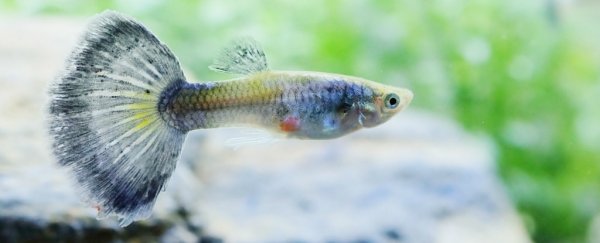Five minutes in the life of a guppy in the terrible spring of 2015:
You're swimming around with your friends in a tank. You've been here for days. Food falls from the sky. Everything is fine.
Then suddenly, you're netted up and dropped into an alien world, all alone, just you and the glass.
You panic at first, but in time your courage returns and you investigate. Glass wall; glass wall; glass wall; glass wall. A scrap of plastic on the aquarium floor provides the only scant shelter. Hmm …
Splash! A huge beak crashes into the water. If you knew what the University of Exeter is, you might wonder how a heron even got inside. Instead, you just cower under the plastic and wait for death.
But the beak does not return, and you peek out after a minute or so, and soon the net delivers you back to familiar surroundings. Food and friends again. The terrible memory fades, and life returns to normal.
For three days.
Then the net again, and the same strange tank of terror. Again and again and again - for you are a guppy in Tom Houslay's lab, and he wants to understand the very core of your being.
just let me have a weekend dammit pic.twitter.com/x5bXoPbpGu
— Tom Houslay (@tomhouslay) November 26, 2016
The fish could have been any one of the 105 Trinidadian guppies that Houslay's team at Exeter's Penryn campus subjected to regular doses of fear two years ago, in an effort to determine whether they have personalities.
It turns out they do, of a sort.
According to the team's study, published Monday in the journal Functional Ecology, each fish demonstrated a unique response to stress - which they endured every three days in the form of a pulley-rigged lawn-ornament heron named "Grim," or a predatory cichlid suddenly revealed on the other side of the glass.
"Some of them go straight to the shelter," said Houslay, an evolutionary biologist and the study's lead author.
"Some just stop moving, maybe hoping they won't be seen. Some rush to the side and just swim up and down trying to escape."
This may not surprise anyone who's kept an aquarium, but Houslay's team went much further than your average fish gazer.
They injected color-coded polymers under the scales of the guppies, which were randomly selected from a population that grew up at the university - descendants of the wild inhabitants of the Aripo River in Trinidad.
The researchers filmed, timed and analysed each fish as it coped with the horror of Grim or the cichlid, nicknamed "Big Al."
By measuring how long each guppy stayed hidden, frozen or otherwise panicked, the researchers determined that some fish were naturally cowards, and some were relatively brave.
And that wasn't a fluke. The guppies kept proving their cowardice or braveness in repeated tests - every three days for four weeks.
"We see quite complex strategies; more complex than we thought," Houslay said. "The variation isn't just random. There's something more meaningful going on."
In other words, all those apparently identical little fish, who all grew up in the same cushy lab tanks, nevertheless developed unique character traits.
Not as complex as ours maybe, but the fish are all individuals. And that's important to the study of evolution.
Scientists have long known about such differences in other animals, Houslay said - from chickadees to prawns.
But guppy personalities hadn't been studied well, he said. And the species makes especially useful subjects for evolutionary biologists because communities mature rapidly and - in their native Trinidad - face vastly different environmental challenges depending on what type of predators live in their particular stream.
Wonderfully charming figures of experimental setups from 1990 fish personality experiments https://t.co/beiPbXYYUs pic.twitter.com/3rrXGlmic8
— Tom Houslay (@tomhouslay) January 9, 2017
Now that Houslay knows guppies have personalities, regardless of where they grew up, he wants to know if bravery and cowardice are passed on genetically, from mother guppy to guppy son.
So his team is breeding the next generation of test subjects - a sprawling family of brother and sister and half-sibling guppies, who will all face their own stress tests.
As for the 105 subjects who witnessed Grim and Big Al, Houslay said, they all went back to their home tanks "to live happy lives again."
2017 © The Washington Post
This article was originally published by The Washington Post.
